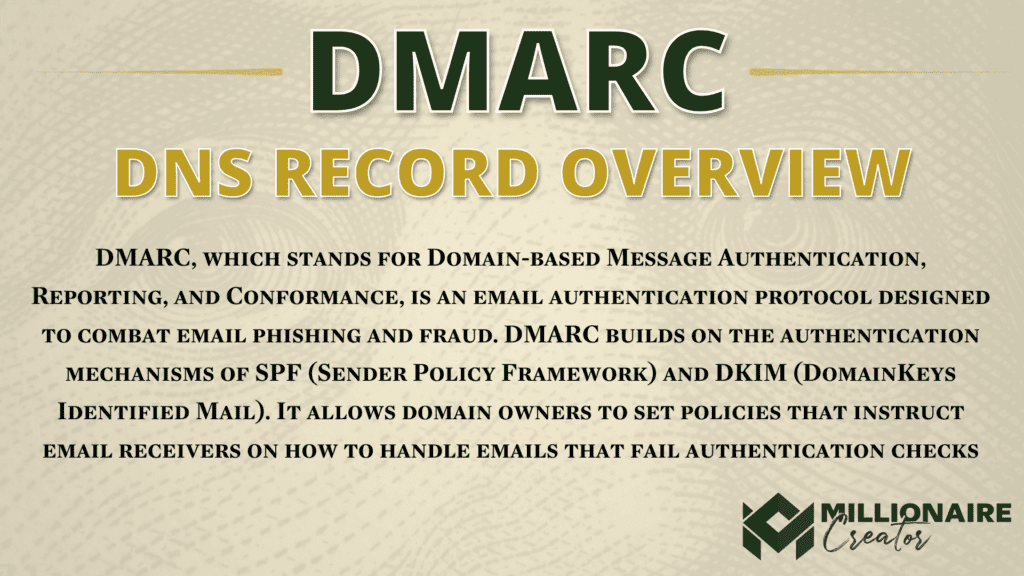
Overview:
DMARC (Domain-based Message Authentication, Reporting and Conformance) is an email authentication protocol that provides a way for email domain owners to protect their domain from unauthorized use in email messages, such as phishing and email spoofing. Having a DMARC record allows domain owners to publish policies in their DNS records, which specify how their emails should be authenticated, and what action to take if authentication fails. A DMARC policies can be set to monitor email traffic, reject or quarantine messages that fail authentication, or take no action.

This record is important because it helps protect your email domain and reputation by preventing unauthorized use of your domain name in phishing and spam emails. By implementing DMARC, you can also receive reports on email traffic and authentication results, allowing you to identify and resolve any issues with your email authentication.

Step by step guide on how to set up a DMARC record:
- Review your current email authentication practices: Before setting up a DMARC record, you should review your current email authentication practices, such as SPF and DKIM, to ensure they are properly set up and configured. This will help ensure that your DMARC policy works as intended.
- Determine your DMARC policy: You will need to determine your DMARC policy, which specifies how email receivers should handle emails that fail authentication from your domain. You can choose to either reject, quarantine, or simply monitor such emails
- Create a DMARC record: Once you have determined your DMARC policy, you will need to create a DMARC record in your DNS. To do this, log in to your DNS management console and create a TXT record with the name “_dmarc” and the value containing your DMARC policy. For example, if you want to monitor all email traffic from your domain, your DMARC record might look like this: _dmarc.yourdomain.com. TXT “v=DMARC1; p=none; rua=mailto:dmarc@yourdomain.com”
In this example, “p=none” instructs email receivers to monitor email traffic and report back to you on email authentication results. “rua” specifies the email address where these reports should be sent. RUA “Aggregate Reporting URI” mechanism to provide detailed reports within XML, JSON, or CSV format
4. Publish your DMARC record: Once you have created your DMARC record, you will need to publish it to your DNS. This can take anywhere from a few minutes to several hours to propagate
5. Monitor your DMARC reports: After you have published your DMARC record, it is important to monitor your DMARC reports to ensure that your email authentication is working as intended. You can use these reports to identify and resolve any issues with email authentication.
6. Adjust your DMARC policy as needed: If you notice issues with your email authentication, you may need to adjust your DMARC policy. For example, you might choose to quarantine or reject emails that fail authentication to better protect your domain from phishing and spam emails.
Overall, setting up a DMARC record can help protect your domain from unauthorized use in emails, and it’s an important step towards improving email security.
Please Note ** DMARC records are required for implementing a BIMI record
Properly configuring your DMARC record for creating a BIMI record
To set up a BIMI record, you must first have a properly configured DMARC record for your domain. This is because BIMI (Brand Indicators for Message Identification) uses the DMARC protocol to verify the authenticity of the email sender. Specifically, your DMARC policy must be set to either “quarantine” or “reject” mode, as BIMI requires a DMARC policy of at least “quarantine” to be implemented. This means that any email that fails DMARC authentication will either be quarantined or rejected, rather than delivered to the recipient’s inbox.

A BIMI record, short for Brand Indicators for Message Identification record, is a DNS (Domain Name System) record that allows organizations to associate their brand logo with their domain name.
Top 5 Benefits of having a company BIMI Record
Increase your open rates estimated (10-15%)
Drastically increase email deliverability due to proper DNS setup
Brand Authority and Trust – Stand out in your emails
Enhanced email reputation
Helps prevent email spoofing / phishing









